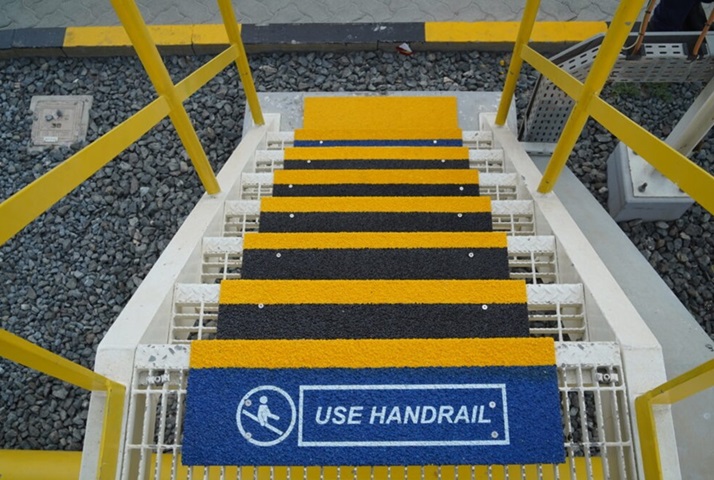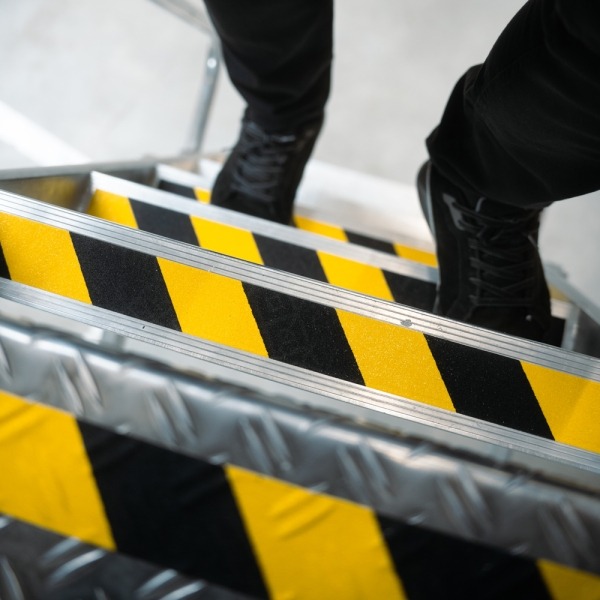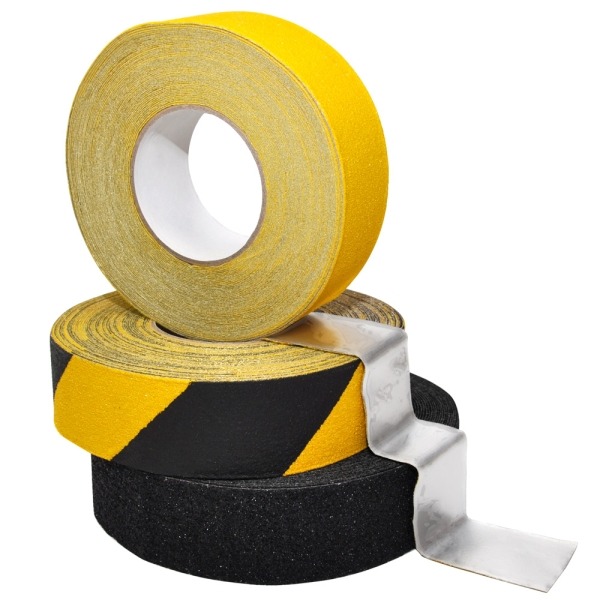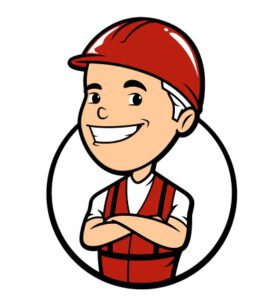High-performance anti-slip systems for industrial, construction, and offshore environments by the anti-slip expert „Antirutschprofi“. Our „non-slip“ products offer maximum safety & compliance.
Discover a comprehensive range of professional anti-slip solutions for industry, construction, and offshore applications, including anti-slip tape, stair tread covers, non-slip stair treads, anti-slip ladder rungs, floor plates/gratings, anti-slip floor coatings, non-slip floor covering, or anti-slip strips. These solutions are crucial in various industries, particularly where slippery surfaces pose safety risks.
 anti-slip steps with non-slip stair treads
anti-slip steps with non-slip stair treads
Where are anti-slip solutions typically used?
- Food Industry: Production facilities, warehouses, and refrigeration units where spills of liquids like water, oils, and food waste may occur.
- Logistics and Warehousing: Warehouses, cold storage units, loading docks, ramps, and areas where pallets and goods are moved to prevent falls and accidents.
- Healthcare: Hospitals, care facilities, and medical laboratories to prevent slip accidents on floors often contaminated with water, disinfectants, and other liquids.
- Retail: Supermarkets, malls, and stores to protect customers from falls on smooth floors, especially in areas like produce sections where food spills can occur.
- Shipbuilding and Shipping: On ships, boats, and dock facilities to reduce the risk of falls on wet decks or during inclement weather.
- Sports and Leisure: In swimming pools, gyms, sports stadiums, and recreational facilities to prevent accidents on slippery surfaces, especially in environments where water is present.
- Construction Industry: On construction sites, stairs, scaffolding, and temporary walkways to protect construction workers from falls and injuries, especially in adverse weather or muddy conditions.
- Chemical Industry: In production plants, labs, and warehouses where hazardous chemicals may spill to prevent workplace accidents and ensure employee safety.
- Oil and Gas Industry / Offshore: On drilling rigs, production platforms, and other offshore facilities where marine conditions and oil or chemical spills can lead to extremely slippery surfaces.
- Wind Energy Industry: On wind turbines, wind farms, and in wind parks where maintenance work is performed at great heights and slippery conditions occur due to moisture, rain, or ice.
 anti-slip tape for stairs
anti-slip tape for stairs
What are the slip resistance classes?
Slip resistance classes classify flooring based on their slip resistance properties, aiming to assess the slippery hazard of floor surfaces and ensure safety in various environments. The classes range from R9 to R13, with R9 having the lowest slip resistance and R13 the highest. Here’s a brief description of slip resistance classes:
- R9: Low slip resistance suitable for low-risk areas like dry areas.
- R10: Medium slip resistance suitable for moderate-risk areas like bathrooms or locker rooms.
- R11: Increased slip resistance suitable for higher-risk areas like kitchens or wet areas.
- R12: Higher slip resistance suitable for high-risk areas like public pools.
- R13: Highest slip resistance suitable for extremely high-risk areas like industrial kitchens or food processing areas.
Choosing the right slip resistance class according to specific usage environments and regulations is crucial to avoiding accidents and injuries: DGUV Rule 108-003: Floors in workrooms and work areas with a risk of slipping.
 non-slip tape
non-slip tape
Types of Anti-Slip Tapes offered
| Parameter | Typical Value / Range | Notes |
|---|
| Slip resistance rating | R11 to R13 (according to DIN 51130) | R13 for highest-duty industrial use. Eg: one photoluminescent product shows R13. |
| Carrier material | PVC-film, aluminium foil, or steel-plate composite | Choice affects conformability, durability |
| Abrasive/grit surface | Aluminium-oxide particles or corundum granulate | For traction on smooth/contaminated surfaces |
| Adhesive type | Acrylic or solvent-based pressure sensitive adhesive | Good adhesion to steel, concrete etc. |
| Installation / application temperature | From approx. −10 °C up to +50-80 °C depending on product | |
| Chemical / environmental resistance | Designed for water, oil, chemicals, UV exposure, etc. | Crucial for industrial & offshore applications |
| Available widths/lengths | Widths e.g. 25-100 mm, lengths e.g. 18 m typical roll | One spec: widths 25, 50, 100 mm, length 18 m. |
| Surface finish / special features | Standard grit, heavy duty, photoluminescent, removable, transparent | Eg: photoluminescent version R13. |
| Suitability for substrates | Concrete, steel plate, tile, GRP, stairs, ramps | See spec sheet for substrate prep. |
| Maintenance / life expectancy | Varies by environment; heavy-duty may last years with minimal upkeep | Useful to advise clients accordingly |
 The Anti-Slip Professionals.
The Anti-Slip Professionals.
What slip-resistance classes are available?
Our solutions follow DIN 51130 and offer ratings from R9 to R13, with R13 designed for highly slippery industrial or offshore environments.
Can anti-slip systems be installed during operation?
Yes. Many products – especially tapes and foils – can be installed without shutting down production.
How long do anti-slip coatings last?
Depending on the environment, coatings typically last 3–7 years, tapes 1–3 years, sometimes longer with maintenance and depending on traffic
Are your products suitable for oil-contaminated surfaces?
Yes – we provide specialized oil-resistant and chemical-resistant anti-slip systems.
Can existing floors be retrofitted?
Absolutely. Our non-slip products are designed for fast retrofit without major construction work.
Is there a difference between the terms “non-slip” and “anti-slip”?
No – both terms mean the same thing. Non-slip and anti-slip describe surfaces, tapes, or coatings designed to increase friction and which reduce the risk of slipping. Depending on the region, one term is simply more common:
- Anti-slip is widely used in Europe and industrial environments.
- Non-slip is more common in everyday English and in the US market. „non-slip“ actually means reduced slip.
All our products work for both search intents and meet professional slip-resistance standards such as DIN 51130 (R9–R13).
Do you export your non-slip products internationally
Yes — we export our non-slip systems across Europe and beyond. Whether you’re located in the DACH region, EU or an overseas location, we can supply to you our products.